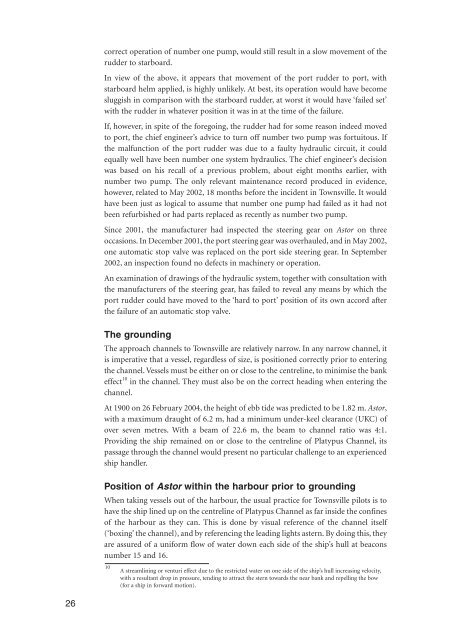MARINE SAFETY INVESTIGATION REPORT No. 200
MARINE SAFETY INVESTIGATION REPORT No. 200
MARINE SAFETY INVESTIGATION REPORT No. 200
You also want an ePaper? Increase the reach of your titles
YUMPU automatically turns print PDFs into web optimized ePapers that Google loves.
26<br />
correct operation of number one pump, would still result in a slow movement of the<br />
rudder to starboard.<br />
In view of the above, it appears that movement of the port rudder to port, with<br />
starboard helm applied, is highly unlikely. At best, its operation would have become<br />
sluggish in comparison with the starboard rudder, at worst it would have ‘failed set’<br />
with the rudder in whatever position it was in at the time of the failure.<br />
If, however, in spite of the foregoing, the rudder had for some reason indeed moved<br />
to port, the chief engineer’s advice to turn off number two pump was fortuitous. If<br />
the malfunction of the port rudder was due to a faulty hydraulic circuit, it could<br />
equally well have been number one system hydraulics. The chief engineer’s decision<br />
was based on his recall of a previous problem, about eight months earlier, with<br />
number two pump. The only relevant maintenance record produced in evidence,<br />
however, related to May <strong>200</strong>2, 18 months before the incident in Townsville. It would<br />
have been just as logical to assume that number one pump had failed as it had not<br />
been refurbished or had parts replaced as recently as number two pump.<br />
Since <strong>200</strong>1, the manufacturer had inspected the steering gear on Astor on three<br />
occasions. In December <strong>200</strong>1, the port steering gear was overhauled, and in May <strong>200</strong>2,<br />
one automatic stop valve was replaced on the port side steering gear. In September<br />
<strong>200</strong>2, an inspection found no defects in machinery or operation.<br />
An examination of drawings of the hydraulic system, together with consultation with<br />
the manufacturers of the steering gear, has failed to reveal any means by which the<br />
port rudder could have moved to the ‘hard to port’ position of its own accord after<br />
the failure of an automatic stop valve.<br />
The grounding<br />
The approach channels to Townsville are relatively narrow. In any narrow channel, it<br />
is imperative that a vessel, regardless of size, is positioned correctly prior to entering<br />
the channel. Vessels must be either on or close to the centreline, to minimise the bank<br />
effect 10 in the channel. They must also be on the correct heading when entering the<br />
channel.<br />
At 1900 on 26 February <strong>200</strong>4, the height of ebb tide was predicted to be 1.82 m. Astor,<br />
with a maximum draught of 6.2 m, had a minimum under-keel clearance (UKC) of<br />
over seven metres. With a beam of 22.6 m, the beam to channel ratio was 4:1.<br />
Providing the ship remained on or close to the centreline of Platypus Channel, its<br />
passage through the channel would present no particular challenge to an experienced<br />
ship handler.<br />
Position of Astor within the harbour prior to grounding<br />
When taking vessels out of the harbour, the usual practice for Townsville pilots is to<br />
have the ship lined up on the centreline of Platypus Channel as far inside the confines<br />
of the harbour as they can. This is done by visual reference of the channel itself<br />
(‘boxing’ the channel), and by referencing the leading lights astern. By doing this, they<br />
are assured of a uniform flow of water down each side of the ship’s hull at beacons<br />
number 15 and 16.<br />
10<br />
A streamlining or venturi effect due to the restricted water on one side of the ship’s hull increasing velocity,<br />
with a resultant drop in pressure, tending to attract the stern towards the near bank and repelling the bow<br />
(for a ship in forward motion).
















